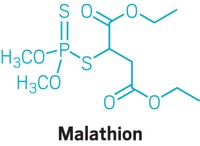Advertisement
Grab your lab coat. Let's get started
Welcome!
Welcome!
Create an account below to get 6 C&EN articles per month, receive newsletters and more - all free.
It seems this is your first time logging in online. Please enter the following information to continue.
As an ACS member you automatically get access to this site. All we need is few more details to create your reading experience.
Not you? Sign in with a different account.
Not you? Sign in with a different account.
ERROR 1
ERROR 1
ERROR 2
ERROR 2
ERROR 2
ERROR 2
ERROR 2
Password and Confirm password must match.
If you have an ACS member number, please enter it here so we can link this account to your membership. (optional)
ERROR 2
ACS values your privacy. By submitting your information, you are gaining access to C&EN and subscribing to our weekly newsletter. We use the information you provide to make your reading experience better, and we will never sell your data to third party members.
Policy
Pesticide Priorities
EPA assistant administrator sees opportunities in complex challenges, but resources have dwindled
by Britt E. Erickson
June 23, 2014
| A version of this story appeared in
Volume 92, Issue 25
Protecting honeybees and other pollinators. Settling lawsuits related to endangered species. Seeking common ground on U.S. and European Union pesticide policies, particularly regarding endocrine disruptors. Those are just some of the latest challenges facing the Environmental Protection Agency’s pesticides office.
These challenges are growing more complex at the same time that EPA’s resources are declining. The agency’s pesticides office saw a 13% drop in its workforce and a 6% decrease in appropriations from fiscal 2012 to 2014.
On top of that, productivity within the pesticides office has fallen an estimated 10–15% over the past year. EPA officials point to the two-week government shutdown last fall over the budget impasse and a handful of mandatory EPA-wide furlough days in 2013 as the reasons behind this drop. The time the agency takes to make decisions related to pesticide approvals has grown, pesticide products are being delayed from entering the market, and the office is in catch-up mode.
Overseeing this situation is Jim Jones, assistant administrator for EPA’s Office of Chemical Safety & Pollution Prevention. EPA’s Office of Pesticide Programs, which registers new pesticides and reviews and regulates those on the market, is one of three offices under Jones’s purview.
Confirmed last August by the Senate, Jones manages implementation of the nation’s pesticide, toxic chemical, and pollution prevention laws. Jones, who directed the Office of Pesticide Programs from 2003 to 2007, has seen a lot of changes related to the management of pesticides over the past decade.
REGULATIONS
EPA’s Office Of Pesticide Programs Has A Full Plate
Pollinator Protection
◾ Label changes were required for neonicotinoid insecticides as of last year to protect pollinators. EPA will broaden the rule this summer to cover other insecticides.
◾ A residual toxicity database will be released in July. It will include information about how long pesticides remain toxic to bees.
◾ EPA developed a method for assessing the impacts of all existing pesticides on honeybee colonies. Pesticide manufacturers are currently conducting those studies.
Endangered Species
◾ EPA is proposing a settlement in a lawsuit involving Pacific Northwest salmon and the spraying of five pesticides: carbaryl, chlorpyrifos, diazinon, malathion, and methomyl.
◾ A new process is being implemented to evaluate the impact of existing pesticides on endangered species, as recommended by the National Research Council.
U.S.-EU Free-Trade Agreement
◾ Disagreement over how to assess chemicals for endocrine-disrupting characteristics threatens to be a deal-breaker in transatlantic trade pact talks.
◾ U.S. government officials are working with European Commission officials to harmonize their different approaches for evaluating endocrine disruptors.
At the top of his priority list for pesticides is protecting honeybees and other pollinators, Jones tells C&EN. EPA is tackling the problem from multiple angles, he says. For example, EPA last summer required manufacturers of a class of insecticides called neonicotinoids to change their labels “in a way that we think is more protective of pollinators,” Jones says. Specifically, the labels must carry an icon of a bee to signal the pesticide’s potential risk to bees. The labels also must alert users that application of the product is prohibited when bees are present.
Because neonicotinoids are not the only class of pesticides that can harm bees, EPA plans to broaden the labeling requirements later this year to include any insecticide that is toxic to bees, he says.
EPA is currently evaluating all existing pesticides for their impact on bees. The process has slowed down because the agency opted to design a study to look at the effects of each pesticide on a whole colony of bees, Jones says. Historically, EPA has evaluated the acute effects of pesticides on individual bees, not entire populations.
Manufacturers of several pesticides are now conducting those population-level studies on bees. “They are going to be instrumental in our ultimate assessment,” Jones says.
EPA is also working to persuade seed companies to use a new agent that helps keep pesticides on treated seeds during planting. The dust that is created when chemicals are dislodged from treated seeds can blow off site and potentially expose bees to the pesticide. “We’ve worked with manufacturers to come up with a better sticking agent so that the pesticide doesn’t blow off the seed,” Jones says. There was some adoption of the new agent this year. “EPA is hoping that by 2015 it becomes the standard,” he adds.
Later this summer, EPA also plans to make available a set of data on residual toxicity of pesticides that can harm bees. The information will provide applicators and farmers with an indication of how long a pesticide they are considering using will remain toxic to bees. “Ideally, if you are in and around bees, you will use chemicals with a shorter residual toxicity rather than a longer one,” Jones says.
Protecting bees is only one worry of the pesticides office. EPA has been sued repeatedly for more than a decade for failing to consult with other federal agencies about the impacts of pesticides on endangered species. The litigation is draining resources and time, making it difficult for EPA to conduct routine business, according to Jones.
“So far we have not missed any of the deadlines in our settlement agreements in any of the litigation we have had,” Jones says. But he says the concerted effort required to meet the court-supervised deadlines “has made it hard to focus on the normal course of business,” notably the agency’s reviews of the registration of pesticides currently on the market.
In one lawsuit, brought by the Northwest Center for Alternatives to Pesticides and others in Washington state, EPA earlier this month proposed a settlement agreement that would institute no-spray zones for five pesticides—carbaryl, chlorpyrifos, diazinon, malathion, and methomyl—in the Pacific Northwest to protect endangered salmon. The no-spray zones would remain in place until EPA implements any other protections based on consultations with the National Marine Fisheries Service (NMFS). EPA is reevaluating the five pesticides as part of its registration review effort.
EPA began a new process earlier this year for considering impacts on endangered species as part of its periodic review of existing pesticides. Previously, the agency conducted a risk assessment, then the Fish & Wildlife Service or NMFS would conduct its own analysis, using a different approach. Now, the agencies are working together early in the process using a streamlined approach that the National Research Council recommended last year.
After the agencies complete the consultation process for the five pesticides identified in the proposed settlement, they will move on to the hundreds of other pesticides named in lawsuits related to endangered species protection.
Looking beyond existing pesticides, EPA is encouraging manufacturers to design new active ingredients that are safer for the environment, human health, and endangered species. EPA plans to use a hazard assessment to determine whether new chemicals are safer than those on the market.
“If we find they are safer, which tends to be the case with very few exceptions, we will look at that endangered species aspect later down the road when we do the registration review,” Jones says. “If they are not safer, then we will give serious consideration to doing an endangered species assessment at that point in time.”
But that approach concerns pesticide manufacturers, who want EPA to conduct a risk assessment, which takes into account both hazard and exposure. Basing regulatory policy on hazard alone does not take into account whether safe uses can be identified or the likelihood of exposure, they argue.

Industry groups are raising a similar argument regarding hazard and risk in discussions about a free-trade agreement being negotiated between the U.S. and the European Union. A substantial part of that accord, called the Transatlantic Trade & Investment Partnership, concerns agriculture, including pesticides. Government officials hope to have a deal by the end of the year. But disagreement over one group of chemicals—endocrine disruptors—threatens to derail the negotiations.
At issue is a regulation being developed in the EU that would classify chemicals as known or suspected endocrine disruptors. Pesticide manufacturers say they weren’t given an opportunity to provide input before the regulation was drafted. They are concerned because the EU’s regulatory approach for endocrine disruptors relies on hazard-based limits to remove products from the market. In contrast, the U.S. is creating a policy on endocrine disruptors using a risk-based management approach, which weighs hazard and exposure information.
The European Commission is still developing the criteria for identifying which substances will be categorized as endocrine disruptors. The process was due to be completed by the end of last year, but it was delayed so the commission could conduct an impact analysis.
The pesticide industry is especially worried because it doesn’t know what the EU will do once a chemical is classified as an endocrine disruptor. A report commissioned by the pesticide industry group CropLife America estimates that the value of U.S. exports potentially blocked by the EU’s choices could be as high as $4 billion annually.
Jones sees emerging policies on endocrine disruptors as an opportunity for the U.S. and EU to seek similar regulatory approaches.
“At a minimum, we should be able to be harmonized on the science,” Jones continues. The U.S. and EU should take into account the same studies and evaluate them using the same criteria, he says. Regulatory action, if any, on a chemical that is found to be an endocrine disruptor will be trickier to harmonize, he points out, because the U.S. and EU have different statutory mandates.
Concerns about endocrine disruptors and U.S.-EU harmonization efforts came up during a recent meeting of the Pesticide Program Dialogue Committee. This group of stakeholders from U.S. industry, academia, and nonprofit advocacy organizations brings various pesticide issues to EPA’s attention.
In general, industry groups are pleased with EPA’s plans to work closely with the EU on streamlining an approach for evaluating endocrine disruptors. EPA has been developing a program to screen chemicals for their ability to mimic estrogen, androgen, and thyroid hormones since the late 1990s. The program, called the Endocrine Disruptor Screening Program, got off the ground in 2009 when EPA issued the first test orders for 67 chemicals, mostly pesticides. The agency is currently evaluating the results of those tests.
“I think Europe can learn a lot from the U.S. experience,” said Ray McAllister, senior director of regulatory policy at CropLife America. “We strongly encourage development of a pilot program for the two agencies to work together on endocrine screening.”
Last year, a coalition of toxicology journal editors and experts in risk assessment sent a letter to the chief scientific adviser to the president of the European Commission, the EU’s executive branch of government. They expressed concerns about the European Commission’s draft regulation on endocrine-disrupting chemicals, claiming that the commission failed to consult with scientific experts and that its approach lacks a scientific basis.
A group of prominent endocrinologists published a rebuttal to that letter, claiming that the toxicologists had “concerns about policy positions framed as scientific ones.” They also highlighted hidden financial conflicts in publications in some of the toxicology journals. The fallout from last year’s spat continues.
Jones and other EPA officials met with EU officials in Brussels earlier this month to try to work out some of the differences in their approaches to endocrine disruptors. That meeting was held in advance of the start of the sixth round of U.S.-EU trade negotiations, which are scheduled to take place next month in Brussels.
“We have a concern in general with the approach that the EU takes to risk management,” said Daniella Taveau, a senior trade adviser in EPA’s Office of Chemical Safety & Pollution Prevention. EPA wants to make sure there is a reasonable relationship between science and the risk-management decision, she said. EPA also wants to ensure that regulations are promulgated in a transparent manner, that information is solicited, and that all available information is considered.
Jones is confident that the U.S. and EU can come closer to agreement on how to evaluate endocrine disruptors and what to do with the results of those evaluations. As EPA moves ahead with its endocrine disruptor program, “now is the time to see how close we can be harmonized with the EU,” he says.
Regulatory bodies in both the U.S. and EU are facing dwindling resources. Working together could be an effective way to share resources, ensure that the science is right, and preempt future trade problems, Jones says.






Join the conversation
Contact the reporter
Submit a Letter to the Editor for publication
Engage with us on Twitter